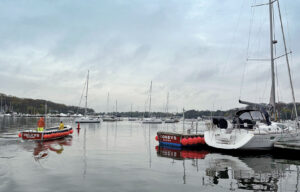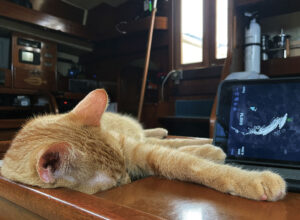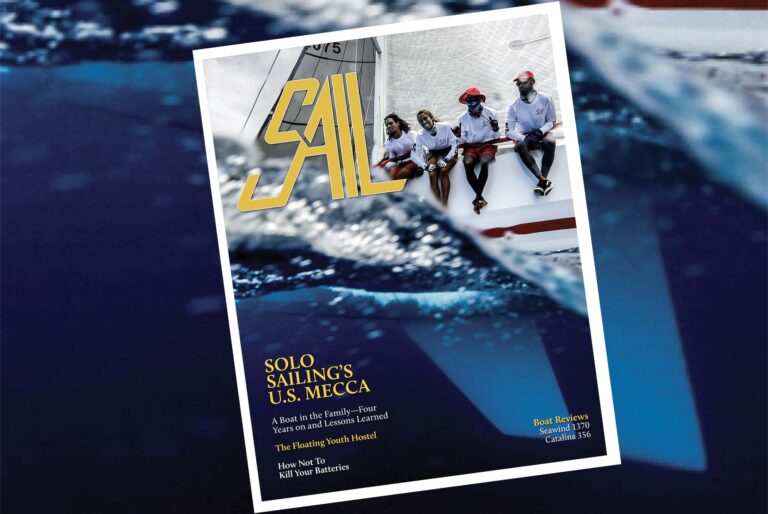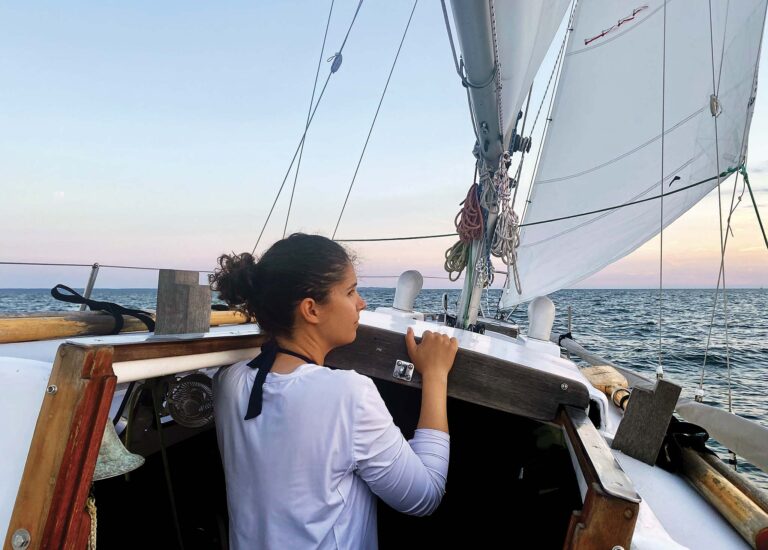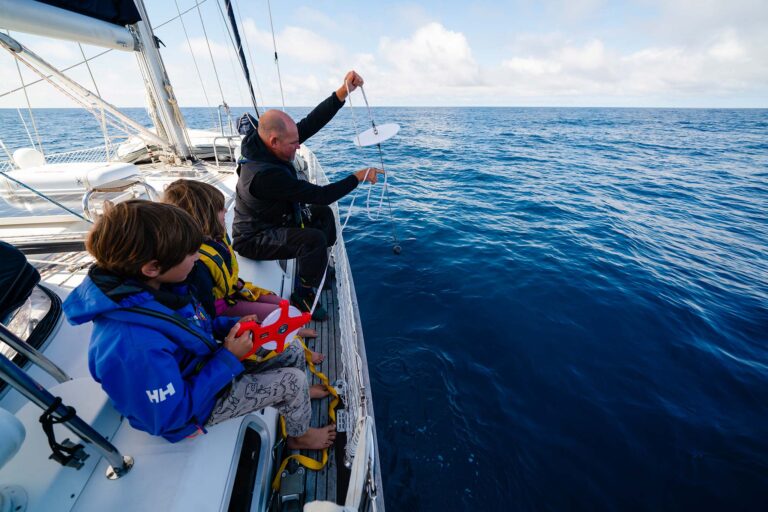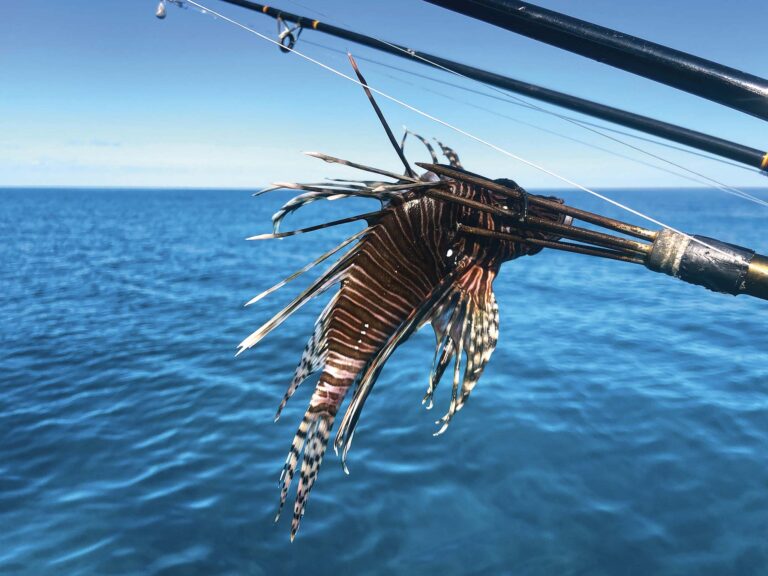Without a doubt the most magical moments I’ve experienced as a sailor have occurred after the sun was down. I will always recall one summer night I spent off the Carolina coast—horizon lost in a low-lying blanket of fog, brilliant shotgun blasts of starlight directly overhead, and the water alive with phosphorescence. When the dolphins came we could see them from a mile off, drilling bright green tunnels of light through the black water. They spiraled about our keel like an acrobatic underwater meteor shower as our sails overhead pulled us on silently toward the dawn.
But I can also remember, just as vividly, another dark night off the New Hampshire coast when I was almost run down by a trawler. An array of running lights that had seemed far away suddenly wasn’t, and though I changed course to avoid them, the other vessel also changed course and continued heading straight for us. Its massive trawling boom swept by so close I swear I could have reached out and touched it. To this day, my heart races at the thought of it.
This is the challenge of sailing at night. It is at once awe-inspiring and potentially terrifying, and to come through in good order with magical memories intact, you need to sail safe and smart.
Standing Watch
Rule number one is to set a watch schedule. Even on a short passage with only one night spent underway, don’t think you can muddle through without one. Crew on deck conning a boat at night need to know when they can stand down; crew members in their berths need to know when they’re expected on deck. The structure of the schedule, however you arrange it, imparts a sense of order and security that helps keep the demons of the night at bay.
Inexperienced crew should not be left to stand a night watch alone, and the skipper should make it clear to all that he or she can be called whenever the crew on deck is nervous or uncertain about what’s going on. At every change of the watch, the crew being relieved should give the new watch a short briefing as to the weather and sea conditions and the state of the vessel, noting in particular any traffic or navigational hazards in the area.
On the first night of a long passage, or on a single-night passage, you may have difficulty falling asleep when off watch. Resist the temptation to stay on deck enjoying the scenery. Even if you can’t sleep, you should stay in your berth resting so you’re as fresh as possible when you are on watch.
Sail Handling
Many skippers like to shorten sail before dark, regardless of conditions, so as to minimize the chance of having to handle sails at night. This is fine, but you should still be willing and able to change sails, or take in or let out reefs, if necessary. It is a very good idea to mark your running rigging so that you can make routine sail-trim settings without having to see the rig. You should also have a working set of deck lights, so you can illuminate everything when doing big jobs.
At the beginning of the night, the skipper should make sure everyone understands what adjustments can be made unsupervised by the watch on deck and when more crew should be called up to assist. This may vary from watch to watch, depending on the crew’s experience. All crew should also be wearing life vests and harnesses, and jacklines should be rigged.
Power Management
On most modern boats, sailing at night consumes an inordinate amount of power. Between your nav lights, autopilot, chartplotter, radar, VHF radio, AIS transceiver and a myriad of illuminated instrument displays, you’ll see your amp-meter spiking a lot higher than it normally does. Be sure your electrical system can handle the load.
You should also do what you can to lighten the load. Dim all your illuminated displays, and have the crew carry small flashlights so they can read in their berths, get dressed, and find gear without having to turn on any cabin lights. (This will also save everyone’s night vision.) If you sail often at night, it’s a good idea to replace any incandescent running lights with LEDs.
Collision Avoidance
On the one hand, it’s often easier to identify traffic at night, as the running lights of other vessels make them visible at much greater distances. On the other, it is much easier to get confused. Lighting on shore can make it especially hard to pick out and track other vessels. Unless you have some experience, it can often be difficult figuring out how another boat is oriented, even if there is a clean horizon behind it.
Yes, modern technology has done much to make all this easier. But not every vessel shows up on a radar screen, nor do they all carry AIS transponders. Only large commercial ships are required to carry AIS; many fishing boats don’t bother with it, and it is these, in particular, that you need to look out for. Their lighting arrays are often confused and irregular, and their movements can be unpredictable. If the crew is busy working, there will typically be no one keeping watch.
To keep your own vessel secure, you need to first make sure your crew understands the technology on your boat. You don’t want them reading instruction manuals by flashlight, so it’s a good idea to deliver thorough briefings as to the operation of any radar and AIS equipment aboard before you leave the dock. Ideally, one member of each watch should also have at least a basic working knowledge of which vessels show which lights, in case your technology is irrelevant.
Again, the crew should not be shy about waking the skipper if there is any threat of a collision. This should always be done sooner rather than later, so the skipper has time to observe the other vessel’s movements before deciding on a course of action.
Clothing and Food
Even in the tropics, it can get quite cool at night, and everyone aboard should have appropriate clothing for keeping dry and warm while on deck. Crew on watch should also have easy access to food and drink. Stash a cache of popular snacks in an easy-to-reach locker and leave out a thermos of hot tea or coffee for those who need a pick-me-up in the middle of a long graveyard watch.
If you and your crew are warm, well fed and feel secure about the procedures on your boat, you’ll be all set to savor and enjoy the very special experience that is sailing at night.
Photo by Oriol Clavera (top); by Tor Johnson (bottom)


